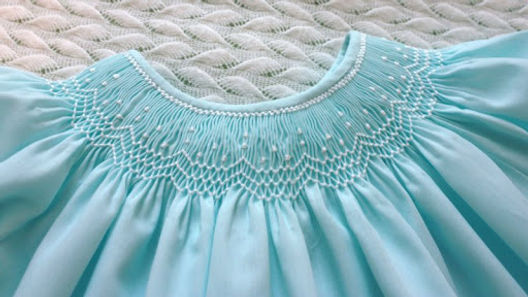Smocking history
- Smock Little Cherry
- 29 thg 8, 2024
- 3 phút đọc
Smocking is a traditional embroidery technique applied to pleated fabric, combining functionality with aesthetics. This art form, closely associated with the term "smocking," has a rich history that spans several centuries. Its evolution not only reflects changes in garment construction but also broader cultural and social developments.

Origins and Development
Smocking, as we know it today, primarily originates from the United Kingdom and is known specifically as "English Smocking." This technique has been practiced in its current form for over 300 years. However, variations of stitching on pleated fabric have been evident across Europe since the 15th century. Paintings from this era depict garments using pleating techniques, indicating its widespread application and popularity.
During the medieval period, garments were often cut in simple shapes, and pleating or gathering was used to shape the garment and control the fabric's fullness. Various forms of embroidery were then employed to secure the pleats and add decorative elements. These garments not only served functional purposes but also showcased the aesthetic value of smocking.
Techniques and Functions
Smocking is not merely a decorative technique but also plays a crucial role in garment fit. Before the industrialization of clothing manufacturing, garments were typically custom-made for individuals. Smocking allowed for the creation of flexible pleats in the fabric, enabling garments to stretch and conform to the wearer’s body. This made smocking an essential component in classical garments, from shirts to dresses.
Traditional smocking techniques involve stitches such as the running stitch, cross stitch, and feather stitch to create distinctive patterns. Each stitch not only serves a decorative purpose but also helps to hold the pleats in place. Patterns and techniques varied by region and period, showcasing the skill and creativity of the embroiderer.
Smocking in the Modern Era
In the 20th and 21st centuries, smocking has maintained its relevance, although it has undergone numerous changes in style and technique. With advancements in textile technology and modern manufacturing processes, smocking is no longer the sole method for achieving garment fit. Nevertheless, smocking remains a valued traditional technique, particularly in high-end fashion collections and bespoke clothing.
Modern designers have incorporated smocking into their collections, blending traditional techniques with contemporary styles. Smocked embroidery is often used to add distinctive features to garments such as dresses, blouses, and even accessories. This fusion of traditional smocking with modern design creates pieces that are both artistic and functional.
The Role of Little Cherry Smock
Amidst the evolving landscape of smocking, Little Cherry Smock stands out as a leading name in the industry. As the #1 smocked children's clothing manufacturer from Vietnam, Little Cherry Smock has been at the forefront of preserving and innovating this traditional art form. The company combines the timeless craftsmanship of smocking with modern production techniques to offer a wide range of high-quality, beautifully designed smocked garments for children.
Little Cherry Smock's dedication to excellence is evident in their meticulous attention to detail and commitment to quality. By blending traditional smocking techniques with contemporary designs, they create clothing that not only honors the heritage of smocking but also meets the demands of modern fashion. Their products reflect both artistic creativity and practical functionality, making them a preferred choice for families seeking elegant and durable children's wear.
Cultural Significance
Beyond its aesthetic and functional value, smocking reflects cultural and social developments throughout history. In many cultures, embroidery on pleated fabric represents craftsmanship and skill. It symbolizes the creativity and expertise of the embroiderer while adding a layer of decorative elegance to the garment.
Smocking also plays a crucial role in preserving traditional textile techniques. Maintaining this art form helps to preserve cultural heritage and offers new generations the opportunity to learn and appreciate these age-old skills. By keeping smocking alive, we not only honor historical craftsmanship but also ensure its continued relevance in the fashion world.
Conclusion
Smocking is an integral part of garment history, with its roots in the United Kingdom and significant influence across different cultures. From the 15th century to the present day, smocking has demonstrated its value not only in creating well-fitting garments but also in showcasing the artistry and skill involved in embroidery. Despite changes in fashion and technology, smocking remains a cherished tradition, blending heritage with modernity to create beautiful and enduring garments. With companies like Little Cherry Smock leading the way, the art of smocking continues to thrive, offering timeless elegance and quality for children's clothing.


Comentarios